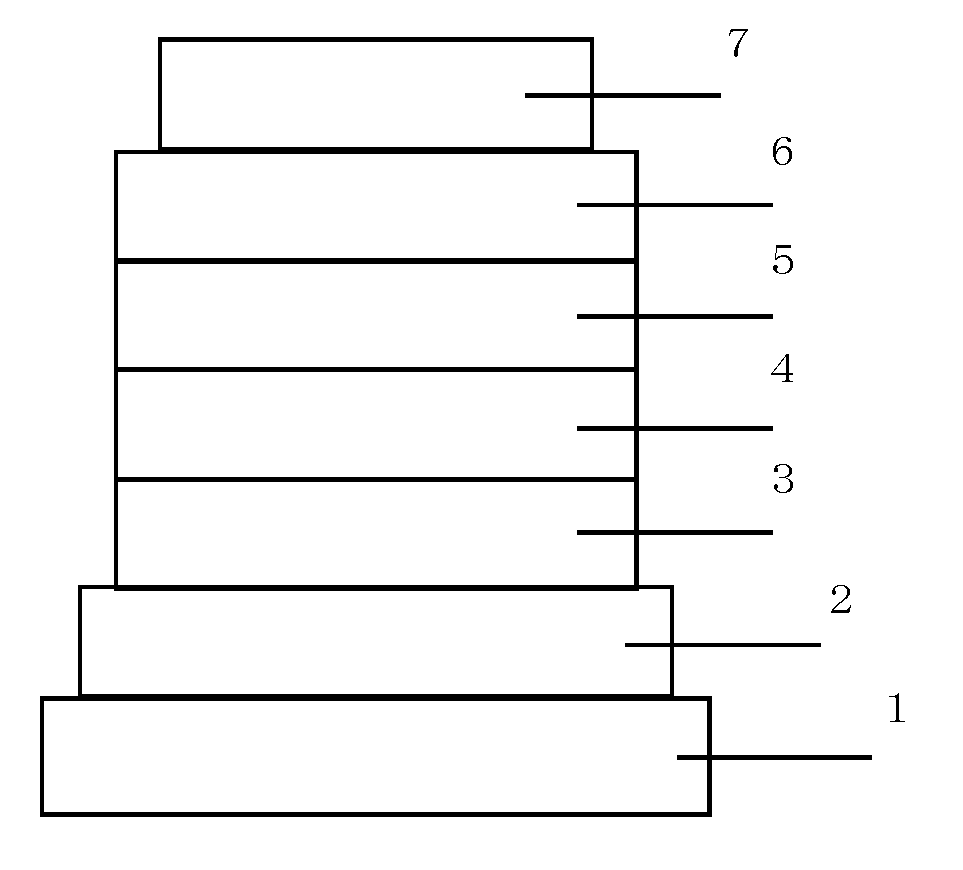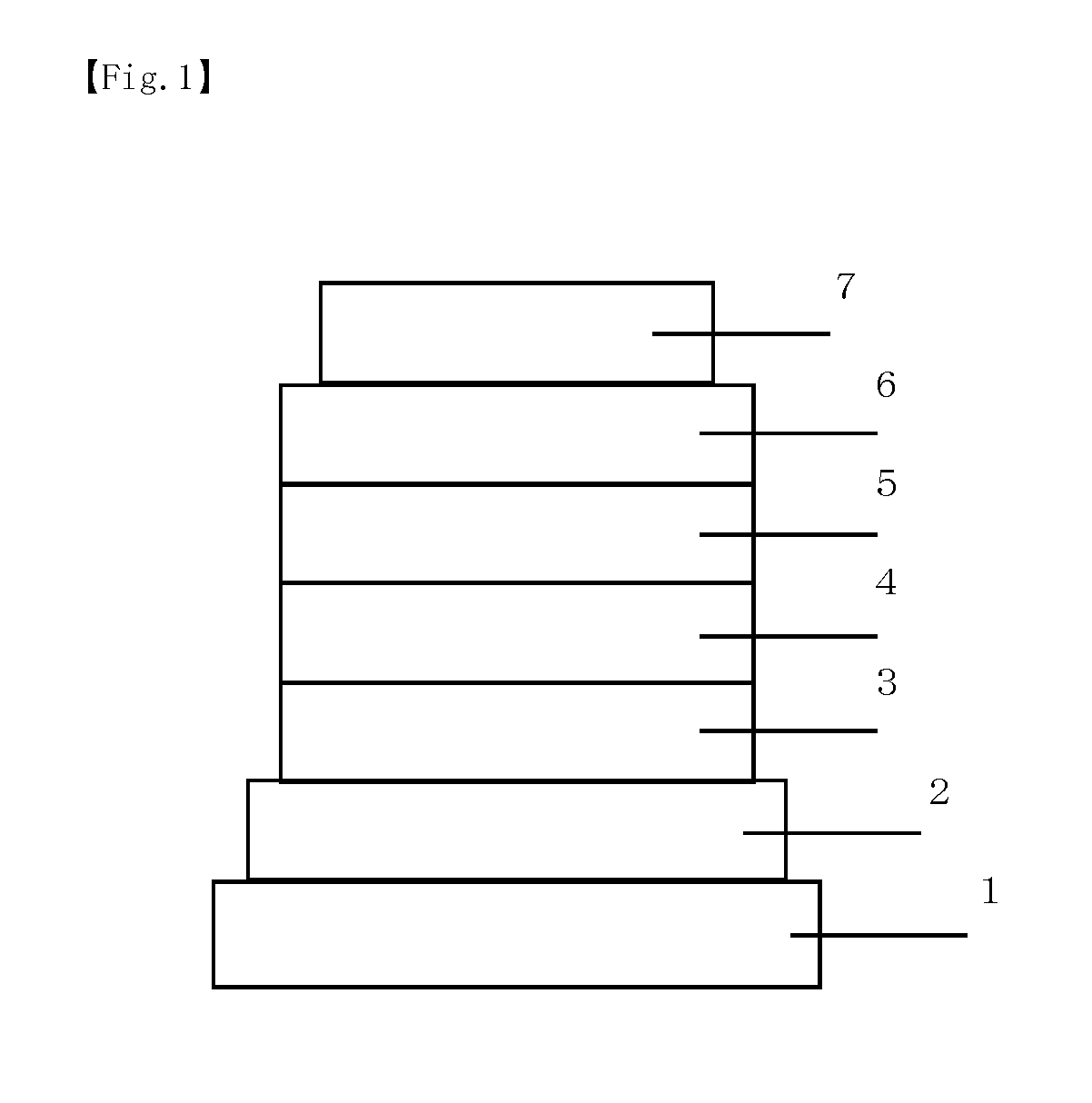Organic electroluminescent device
a technology of electroluminescent devices and electroluminescent tubes, which is applied in the direction of thermoelectric devices, other domestic articles, organic chemistry, etc., can solve the problems of insufficient luminous efficiency of cbp, failure to emit light at high efficiency, and material unsatisfactory for practical use, so as to improve the durability and good hole transport properties , good balance of electrical charges
- Summary
- Abstract
- Description
- Claims
- Application Information
AI Technical Summary
Benefits of technology
Problems solved by technology
Method used
Image
Examples
example 1
Synthesis of Compound 3
[0080]In a 2,000-ml three-necked flask were placed 20 g (59.5 mmol) of 9,10-dibromoanthracene, 20 g (143 mmol) of 3-fluorophenylboronic acid, and 5 g (4.32 mmol) of tetrakis(triphenylphosphine)palladium(0), then 500 ml of ethanol and 600 ml of toluene were added, and the mixture was stirred. A solution of 21.6 g (203.7 mmol) of sodium carbonate in 300 ml of water was then thrown into the flask. Thereafter, the mixture was heated to 100° C. and stirred for 17 hours. The reaction solution was cooled to room temperature, transferred to a 2,000-ml separatory funnel, and separated into an organic layer and an aqueous layer. The organic layer was washed twice with 200 ml of water, then dehydrated over magnesium sulfate, the magnesium sulfate was filtered off, and the solvent was distilled off under reduced pressure. The reaction product thus obtained was then reslurried in 300 ml of methanol to yield 21 g of Intermediate (I) as a white solid.
[0081]Under a nitrogen a...
example 2
Synthesis of Compound 7
[0083]In a 2,000-ml three-necked flask were placed 25 g (74.4 mmol) of 9,10-dibromoanthracene, 22 g (180 mmol) of phenylboronic acid, and 5 g (4.32 mmol) of tetrakis(triphenylphosphine)palladium(0), then 400 ml of ethanol and 600 ml of toluene were added, and the mixture was stirred. Then, a solution of 27 g (254.7 mmol) of sodium carbonate in 250 ml of water was thrown into the flask and the mixture was heated to 90° C. and stirred for 18 hours. The reaction solution was cooled to room temperature, transferred to a 2,000-ml separatory funnel, and separated into an organic layer and an aqueous layer. The organic layer was washed twice with 200 ml of water, then dehydrated over magnesium sulfate, the magnesium sulfate was filtered off, and the solvent was distilled off under reduced pressure. The reaction product thus obtained was then reslurried in 200 ml of ethyl acetate to yield 23 g of Intermediate (III) as a white solid.
[0084]Under a nitrogen atmosphere, 2...
example 3
Synthesis of Compound 16
[0086]In a 500-ml three-necked flask were placed 6.9 g (14.2 mmol) of Intermediate (IV), 4.88 g (17 mmol) of 3-carbazolylphenylboronic acid, and 1 g (0.86 mmol) of tetrakis(triphenylphosphine)palladium(0), then 100 ml of ethanol and 200 ml of toluene were added, and the mixture was stirred. Then, a solution of 4.5 g (42.5 mmol) of sodium carbonate in 50 ml of water was thrown into the flask and the mixture was heated to 90° C. and stirred for 3 hours. The reaction solution was cooled to room temperature, transferred to a 1,000-ml separatory funnel, and separated into an organic layer and an aqueous layer. The organic layer was washed twice with 200 ml of water, then dehydrated over magnesium sulfate, the magnesium sulfate was filtered off, and the solvent was distilled off under reduced pressure. The reaction mixture thus obtained was purified by silica gel column chromatography and then reslurried in methanol to yield 5.4 g of Compound 16.
PUM
 Login to View More
Login to View More Abstract
Description
Claims
Application Information
 Login to View More
Login to View More - R&D
- Intellectual Property
- Life Sciences
- Materials
- Tech Scout
- Unparalleled Data Quality
- Higher Quality Content
- 60% Fewer Hallucinations
Browse by: Latest US Patents, China's latest patents, Technical Efficacy Thesaurus, Application Domain, Technology Topic, Popular Technical Reports.
© 2025 PatSnap. All rights reserved.Legal|Privacy policy|Modern Slavery Act Transparency Statement|Sitemap|About US| Contact US: help@patsnap.com



